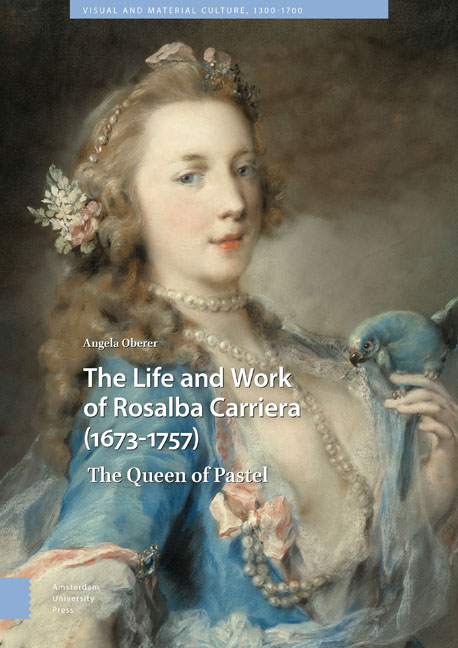Book contents
- Frontmatter
- Contents
- List of Figures and Plates
- Introduction
- 1 Rosalba Carriera – An Independent Single Artist in Eighteenth-Century Venice
- 2 Carriera's Discovery of Pastel Painting
- 3 Carriera's International Network
- 4 Carriera's Stay in Paris
- 5 Carriera's Oeuvre in Pastel
- 6 The Single Woman, the Spinster
- 7 Carriera's Last Journeys – The End of an E`nviable Career
- 8 Carriera's Ways of Self-Fashioning
- Conclusion
- Bibliography
- Index
2 - Carriera's Discovery of Pastel Painting
Published online by Cambridge University Press: 24 November 2020
- Frontmatter
- Contents
- List of Figures and Plates
- Introduction
- 1 Rosalba Carriera – An Independent Single Artist in Eighteenth-Century Venice
- 2 Carriera's Discovery of Pastel Painting
- 3 Carriera's International Network
- 4 Carriera's Stay in Paris
- 5 Carriera's Oeuvre in Pastel
- 6 The Single Woman, the Spinster
- 7 Carriera's Last Journeys – The End of an E`nviable Career
- 8 Carriera's Ways of Self-Fashioning
- Conclusion
- Bibliography
- Index
Summary
The beginning of the eighteenth century represents not only the first high point in Carriera's professional life as an independent artist, with her recognition by the Accademia di San Luca in Rome, but also the period in her life in which she concentrated more and more on a new technique: it was the discovery of the fascination and singularity of pastel painting that proved to be the next milestone in her career. It turned out to be the medium she would show a clear preference for, and she was destined to become the foremost ambassador of this technique. No other artist, let alone female artist, had ever before achieved similar success.
A Short History of Pastel Painting
The English word pastel probably derives from the Italian pastello, a diminutive of the Latin word pasta or paste, and it refers to a form of dry painting. It involves applying pigments to a working surface, usually grainy blue-grey paper, which was originally associated with Venice where it was called ‘Turkish paper’ (carta turchina.) Parchment, card or canvas were other forms of support. The artists used either the pure pigments or, as is normally the case, pastel crayons or sticks. These are fabricated from coloured pigments and a white mineral or pigment, the so-called filler or base to add physical substance. Generally, white chalk of various types was added, or gypsum, starch, plaster of Paris or tobacco-pipe clay and a binder, usually gum Arabic. Shelley describes the process of making crayons as follows:
In the eighteenth century, to create crayons of a uniform and soft consistency the pigment and filler had to be levigated to remove gritty particles, reduced to a fine powder, combined with a binder, ground to a paste with a muller in water of spirits of wine, tempered with a knife, drained on a chalk stone or set on a glass plate to maintain the correct amount of moisture, rolled into cylindrical sticks, and dried.
The paper was dampened and glued to a fine canvas before the pigments were applied to the rough surface, a characteristic of the paper necessary in order for the pigments to adhere. The artists, including Carriera, often used this blue Turkish paper, which was commonly available in smaller dimensions, 37.5 by 46.5 or 41.9 by 52 centimetres.
- Type
- Chapter
- Information
- Life and Work of Rosalba Carriera (1673–1757)The Queen of Pastel, pp. 97 - 114Publisher: Amsterdam University PressPrint publication year: 2020

